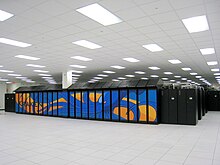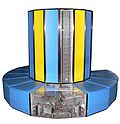
A supercomputer is a computer with a high level of performance as compared to a general-purpose computer. The performance of a supercomputer is commonly measured in floating-point operations per second (FLOPS) instead of million instructions per second (MIPS). Since 2017, there have existed supercomputers which can perform over 1017 FLOPS (a hundred quadrillion FLOPS, 100 petaFLOPS or 100 PFLOPS).

In computing, floating point operations per second is a measure of computer performance, useful in fields of scientific computations that require floating-point calculations. For such cases, it is a more accurate measure than measuring instructions per second.
Cray Inc., a subsidiary of Hewlett Packard Enterprise, is an American supercomputer manufacturer headquartered in Seattle, Washington. It also manufactures systems for data storage and analytics. Several Cray supercomputer systems are listed in the TOP500, which ranks the most powerful supercomputers in the world.

EPCC, formerly the Edinburgh Parallel Computing Centre, is a supercomputing centre based at the University of Edinburgh. Since its foundation in 1990, its stated mission has been to accelerate the effective exploitation of novel computing throughout industry, academia and commerce.
Red Storm is a supercomputer architecture designed for the US Department of Energy’s National Nuclear Security Administration Advanced Simulation and Computing Program. Cray, Inc developed it based on the contracted architectural specifications provided by Sandia National Laboratories. The architecture was later commercially produced as the Cray XT3.

The Cray XT3 is a distributed memory massively parallel MIMD supercomputer designed by Cray Inc. with Sandia National Laboratories under the codename Red Storm. Cray turned the design into a commercial product in 2004. The XT3 derives much of its architecture from the previous Cray T3E system, and also from the Intel ASCI Red supercomputer.

Roadrunner was a supercomputer built by IBM for the Los Alamos National Laboratory in New Mexico, USA. The US$100-million Roadrunner was designed for a peak performance of 1.7 petaflops. It achieved 1.026 petaflops on May 25, 2008, to become the world's first TOP500 LINPACK sustained 1.0 petaflops system.
HECToR was a British academic national supercomputer service funded by EPSRC, Natural Environment Research Council (NERC) and BBSRC for the UK academic community. The HECToR service was run by partners including EPCC, Science and Technology Facilities Council (STFC) and Numerical Algorithms Group (NAG).

The TOP500 project ranks and details the 500 most powerful non-distributed computer systems in the world. The project was started in 1993 and publishes an updated list of the supercomputers twice a year. The first of these updates always coincides with the International Supercomputing Conference in June, and the second is presented at the ACM/IEEE Supercomputing Conference in November. The project aims to provide a reliable basis for tracking and detecting trends in high-performance computing and bases rankings on HPL, a portable implementation of the high-performance LINPACK benchmark written in Fortran for distributed-memory computers.

IBM Sequoia was a petascale Blue Gene/Q supercomputer constructed by IBM for the National Nuclear Security Administration as part of the Advanced Simulation and Computing Program (ASC). It was delivered to the Lawrence Livermore National Laboratory (LLNL) in 2011 and was fully deployed in June 2012. Sequoia was dismantled in 2020, its last position on the top500.org list was #22 in the November 2019 list.
The National Center for Computational Sciences (NCCS) is a United States Department of Energy (DOE) Leadership Computing Facility that houses the Oak Ridge Leadership Computing Facility (OLCF), a DOE Office of Science User Facility charged with helping researchers solve challenging scientific problems of global interest with a combination of leading high-performance computing (HPC) resources and international expertise in scientific computing.

Jaguar or OLCF-2 was a petascale supercomputer built by Cray at Oak Ridge National Laboratory (ORNL) in Oak Ridge, Tennessee. The massively parallel Jaguar had a peak performance of just over 1,750 teraFLOPS. It had 224,256 x86-based AMD Opteron processor cores, and operated with a version of Linux called the Cray Linux Environment. Jaguar was a Cray XT5 system, a development from the Cray XT4 supercomputer.

Tianhe-I, Tianhe-1, or TH-1 is a supercomputer capable of an Rmax of 2.5 peta FLOPS. Located at the National Supercomputing Center of Tianjin, China, it was the fastest computer in the world from October 2010 to June 2011 and was one of the few petascale supercomputers in the world.
The Cray XT6 is an updated version of the Cray XT5 supercomputer, launched on 16 November 2009. The dual- or quad-core AMD Opteron 2000-series processors of the XT5 are replaced in the XT6 with eight- or 12-core Opteron 6100 processors, giving up to 2,304 cores per cabinet. The XT6 includes the same SeaStar2+ interconnect router as the XT5, which is used to provide a 3-dimensional torus network topology between nodes. Each XT6 node has two processor sockets, one SeaStar2+ router and either 32 or 64 GB of DDR3 SDRAM memory. Four nodes form one X6 compute blade.

The Cray XE6 made by Cray is an enhanced version of the Cray XT6 supercomputer, officially announced on 25 May 2010. The XE6 uses the same computer blade found in the XT6, with eight- or 12-core Opteron 6100 processors giving up to 3,072 cores per cabinet, but replaces the SeaStar2+ interconnect router used in the Cray XT5 and XT6 with the faster and more scalable Gemini router ASIC. This is used to provide a 3-dimensional torus network topology between nodes. Each XE6 node has two processor sockets and either 32 or 64 GB of DDR3 SDRAM memory. Two nodes share one Gemini router ASIC.
Kraken was a Cray XT5 supercomputer that entered into full production mode on February 2, 2009. Kraken was operated by the University of Tennessee and was the most powerful computer in the world managed by academia at the time. It was housed in the Oak Ridge Leadership Computing facility at Oak Ridge National Laboratory. Kraken was decommissioned on April 30, 2014.

The K computer – named for the Japanese word/numeral "kei" (京), meaning 10 quadrillion (1016) – was a supercomputer manufactured by Fujitsu, installed at the Riken Advanced Institute for Computational Science campus in Kobe, Hyōgo Prefecture, Japan. The K computer was based on a distributed memory architecture with over 80,000 compute nodes. It was used for a variety of applications, including climate research, disaster prevention and medical research. The K computer's operating system was based on the Linux kernel, with additional drivers designed to make use of the computer's hardware.
The Cray XK6 made by Cray is an enhanced version of the Cray XE6 supercomputer, announced in May 2011. The XK6 uses the same "blade" architecture of the XE6, with each XK6 blade comprising four compute "nodes". Each node consists of a 16-core AMD Opteron 6200 processor with 16 or 32 GB of DDR3 RAM and an Nvidia Tesla X2090 GPGPU with 6 GB of GDDR5 RAM, the two connected via PCI Express 2.0. Two Gemini router ASICs are shared between the nodes on a blade, providing a 3-dimensional torus network topology between nodes. This means that it has 576 GB of Graphics memory and over 1500 CPU cores, several orders of magnitude more powerful than the best publicly available computer on the market.

Approaches to supercomputer architecture have taken dramatic turns since the earliest systems were introduced in the 1960s. Early supercomputer architectures pioneered by Seymour Cray relied on compact innovative designs and local parallelism to achieve superior computational peak performance. However, in time the demand for increased computational power ushered in the age of massively parallel systems.

Titan or OLCF-3 was a supercomputer built by Cray at Oak Ridge National Laboratory for use in a variety of science projects. Titan was an upgrade of Jaguar, a previous supercomputer at Oak Ridge, that uses graphics processing units (GPUs) in addition to conventional central processing units (CPUs). Titan was the first such hybrid to perform over 10 petaFLOPS. The upgrade began in October 2011, commenced stability testing in October 2012 and it became available to researchers in early 2013. The initial cost of the upgrade was US$60 million, funded primarily by the United States Department of Energy.














